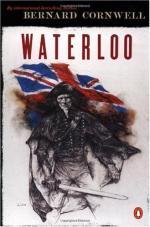
|
| Name: _________________________ | Period: ___________________ |
This test consists of 5 short answer questions, 10 short essay questions, and 1 (of 3) essay topics.
Short Answer Questions
1. What does the horseman's hat look like?
2. Why do the Prince of Orange's men refuse to follow him to attack the French cannon?
3. What is Lucille most afraid of as she says goodbye to Sharpe?
4. What is given to the general of the French dragoons in Charleroi?
5. Who is Prince William of Orange?
Short Essay Questions
1. How does Sharpe mitigate a complete disaster with the battalions under French cavalry attack?
2. Who does Sharpe encounter while escaping the crossroad area and what happens?
3. What is the ultimate end of the second day of the novel?
4. Why is the Duchess of Richmond apprehensive about John Rossendale?
5. What actions of the Dutch-Belgium cavalry in Chapter 7 tell the reader about their ability? What impressions might their actions give?
6. What does Sharpe do when he and Doggett see a battalion of French while scouting the crossroad area?
7. What did the actions in Chapter 7 show about the Prince of Orange and some of the other British officers?
8. What are some of the types of infantry attack used in the battle for Quatre Bras?
9. What is Bonaparte thinking about as he sits in his coach near where the French come into Belgium?
10. What do Sharpe and Harper do on the second night of battle?
Essay Topics
Write an essay for ONE of the following topics:
Essay Topic 1
In any book centered around the military, leadership of the troops is often crucial with the better leaders able to command the respect and loyalty of their men. The men's willingness to follow a particular leader can have a decisive impact upon the success of a mission. Discuss the following:
1. Whose command style seems most effective? Analyze the elements of those effective leaders thoroughly and discuss the traits of the good leaders. What makes an excellent leader/commander? Give examples.
2. Whose command style seems most ineffective? Analyze the elements of those ineffective leaders thoroughly and discuss the traits of the poor leaders. What makes a poor leader/commander? Give examples.
3. Is disobeying a poor leader ever justifiable? Explain using details from the text, other books you have read and your personal experience. In times of war, disobeying an order can be punishable by death. Is this harsh sentence justifiable for such an act? Why or why not.
Essay Topic 2
D'Alembord died of a leg wound. This was a fairly routine occurrence at that time. Choose one of the following to discuss:
1. Compare/contrast the medical remedies used in Sharpe's Waterloo to those which would be used in our modern world.
2. Many wars are partially, if not completely, determined by factors other than the actual fighting. One of those factors is disease. Research and discuss how epidemics/pandemics have influenced the outcome of three different wars throughout history.
3. Discuss why men died so readily of wounds that would be easily treated today.
Essay Topic 3
Cornwell is masterful in his description of battles and life in general for a soldier during the Napoleonic Wars in the early 1820s. Discuss one of the following:
1. Trace and analyze Cornwells's descriptive passages about life as a soldier. How does he use descriptions of the five senses to make the reader feel s/he is there? Do you find his descriptions compelling? Seemingly accurate? How would the novel be different if Cornwell did not include such descriptive passages?
2. Analyze Cornwells's descriptive passages about the social structure of the times and discuss what you think it would be like to be a person of wealth and/or privilege such as John Rossendale, The Prince of Orange, The Duke of Wellington, and Simon Doggett. Contrast that to the lives of those who are in a lower social strata such as Sharpe and Harper or one in service to someone of wealth and/or privilege.
3. Describe and analyze Cornwell's descriptive passages about the topographical setting and the physical descriptions of the people. Does Cornwell do an adequate job of actually making the reader "see" the land/sea where the action is taking place? How about getting a visual image of the characters? How do the descriptions of the setting add to the novel? Do you like having an idea of how a character looks? How would the novel be different without such descriptions?
|
This section contains 1,313 words (approx. 5 pages at 300 words per page) |

|




